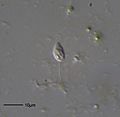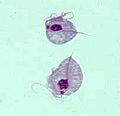Excavata facts for kids
Excavata are a big group of tiny, single-celled living things called eukaryotes. They are part of the domain Eukaryota. These amazing organisms were first talked about in 1999 and officially named in 2002 by Thomas Cavalier-Smith.
Excavata can live freely in nature or live with other organisms, sometimes helping them. Some are even important parasites that can affect humans, like Giardia and Trichomonas. Scientists classify Excavata based on their special whip-like tails called flagella.

Most Excavata cannot make their own food using sunlight (they are non-photosynthetic). The only exception is a group called Euglenozoa. Scientists often divide Excavata into three main groups: Discobids, Metamonads, and Malawimonads.
Contents
What Makes Excavata Special?
Most Excavata are single-celled organisms that get their food from their surroundings. They use their flagella to move around. Only the Euglenozoa group can perform photosynthesis, like plants do.
Some Excavata, especially those that live in places without much oxygen, have very small or changed mitochondria. Mitochondria are like the powerhouses of a cell. Some Excavata don't have "classical" mitochondria at all. Instead, they have modified versions like hydrogenosomes or mitosomes.
Most Excavata have two, four, or even more flagella. Many also have a clear groove on their belly side. This groove is supported by tiny tubes called microtubules. This "excavated" (dug-out) look of the groove is how they got their name! However, some groups that don't have this groove are still considered Excavata because of their genetic makeup.
The Acrasidae slime molds are the only Excavata that can show a little bit of multicellularity. This means they can sometimes act like more than one cell. Like other cellular slime molds, they usually live as single cells. But sometimes, they gather together to form larger groups.
How Excavata are Classified
Scientists group Excavata into several main categories. Here are some of the important ones:
- Discoba: This group includes Tsukubea, Euglenozoa, Heterolobosea (also called Percolozoa), and Jakobea.
- Euglenozoa are a large group that includes many important parasites. Some of them have plastids, which are like tiny factories that make food using sunlight.
- Heterolobosea often switch between having flagella and being amoeba-like forms.
- Jakobea are free-living organisms with flagella. They have mitochondria with a lot of genes.
- Metamonada: This group includes Preaxostyla, Fornicata, and Parabasalia. These groups are special because they have lost their classical mitochondria.
- Preaxostyla are flagellates that either live freely or in the guts of insects.
- Fornicata are mostly organisms that live with or inside animals, often as symbiotes or parasites. Giardia is a well-known example.
- Parabasalia are flagellates that usually live in the guts of insects. Some can cause diseases in humans.
- Malawimonadida: This group includes Malawimonas. They are often considered part of Excavata because of their shape and genetic links to other Excavata groups. However, their exact place among eukaryotes is still being studied.
Discoba Group
The Euglenozoa and Heterolobosea groups seem to be very closely related. They both have disc-shaped structures called cristae inside their mitochondria. These two groups, along with Jakobida, are combined into a larger group called Discoba.
Metamonads
Metamonads are unique because they have lost their classical mitochondria. Instead, they have special modified parts called hydrogenosomes or mitosomes. One type of oxymonad, Monocercomonoides, is even reported to have completely lost these parts!
Are Excavata a Single Group?
Scientists are still trying to figure out if all Excavata truly belong together in one single group (called a monophyletic group). While some smaller groups within Excavata are definitely related, the overall picture is still a bit unclear.
Some scientists used to think Excavata were among the oldest and most basic eukaryotes. However, newer studies suggest that their position on evolutionary trees might be misleading. This can happen due to something called "long branch attraction" in genetic analysis.
Malawimonads
Malawimonads are generally considered part of Excavata because they look like typical Excavata and their genetics sometimes link them to other Excavata groups. But their exact evolutionary position is still a puzzle.
Ancyromonads
Ancyromonads are tiny, free-living cells with a narrow groove on one side. Unlike many other Excavata, they don't use this groove for "suspension feeding" (catching food floating in water). Instead, Ancyromonads catch tiny bacteria that are attached to surfaces. Scientists are still learning about where Ancyromonads fit in the evolutionary tree, but some studies suggest they might be close relatives of malawimonads. This means they could help us understand how "true" Excavata evolved.
Gallery
-
Euglena (Euglenozoa: Euglenoida)
-
Trypanosoma brucei (Euglenozoa: Kinetoplastida)
-
Giardia sp. (Metamonada: Fornicata: Diplomonadida)
Images for kids
See also
 In Spanish: Excavata para niños
In Spanish: Excavata para niños












